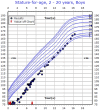Clinical characteristics and long-term management for patients with vitamin D-dependent rickets type II: a retrospective study at a single center in Saudi Arabia
- PMID: 38872968
- PMCID: PMC11169865
- DOI: 10.3389/fendo.2024.1365714
Clinical characteristics and long-term management for patients with vitamin D-dependent rickets type II: a retrospective study at a single center in Saudi Arabia
Abstract
Introduction: Hereditary Vitamin D-dependent rickets type II (HVDDR-type II) is a rare autosomal recessive disorder caused by molecular variation in the gene encoding the vitamin D receptor (VDR). This study aims to evaluate phenotype and genotype characteristics and long-term follow-up of the largest group of patients with (HVDDR-type II) in Saudi Arabia.
Methodology: We conducted a retrospective chart review to collect the clinical, biochemical, and genetic data for all HVDDR-type II patients currently receiving treatment at King Faisal Specialist Hospital & Research Centre, Riyadh, Saudi Arabia.
Results: A total of 42 patients, 57.1% female, and 42.9% male were included in the study. Seven patients were treated with high doses of oral calcium, while 35 patients were treated with IV calcium infusion. The median age at presentation was 15.5 months. Alopecia was found in 97.6%, 21.4% presented with bowing legs, 14.3% with delayed walking, 9.5% with seizure, and 2.4% presented with respiratory failure, while a family history of the disease was positive in 71.4% of total patients. Molecular genetic testing of the VDR gene in our cohort identified six different gene variants c.885 C>A (p.Tyr295Ter), c.88 C>T (p.Arg30Ter), c.1036G>A (p.Val346Met), c.820C>T (p.Arg274Cys), c.803 T>C (p.Ile268Thr), and c.2T>G (p.Met1?).
Conclusion: We are describing the largest cohort of patients with HVDDR-type II, their clinical biochemical findings, and the most prevalent genetic variants in our population.
Keywords: HVDD type II; alopecia; growth retardation; growth velocity; hereditary vitamin D rickets type II; vitamin D.
Copyright © 2024 Alsagheir, Al-Ashwal, Binladen, Alhuthil, Joueidi, Ramzan and Imtiaz.
Conflict of interest statement
The authors declare that the research was conducted in the absence of any commercial or financial relationships that could be construed as a potential conflict of interest.
Figures



Similar articles
-
Hereditary vitamin D resistant rickets (HVDRR) case series: phenotype, genotype, conventional treatment, and adjunctive cinacalcet therapy.Pediatr Endocrinol Diabetes Metab. 2024;30(2):74-80. doi: 10.5114/pedm.2024.139367. Pediatr Endocrinol Diabetes Metab. 2024. PMID: 39026484 Free PMC article.
-
Hereditary vitamin D-resistant rickets presenting as alopecia.Pediatr Dermatol. 2014 Jul-Aug;31(4):519-20. doi: 10.1111/pde.12327. Epub 2014 Jun 11. Pediatr Dermatol. 2014. PMID: 24917549
-
Hereditary vitamin D-resistant rickets: a report of four cases with two novel variants in the VDR gene and successful use of intermittent intravenous calcium via a peripheral route.J Pediatr Endocrinol Metab. 2020 Apr 28;33(4):557-562. doi: 10.1515/jpem-2019-0466. J Pediatr Endocrinol Metab. 2020. PMID: 32049653
-
Genotypic Spectrum and its Correlation with Alopecia and Clinical Response in Hereditary Vitamin D Resistant Rickets: Our Experience and Systematic Review.Calcif Tissue Int. 2023 Apr;112(4):483-492. doi: 10.1007/s00223-023-01061-8. Epub 2023 Jan 27. Calcif Tissue Int. 2023. PMID: 36705686
-
Genotype and phenotypic spectrum of vitamin D dependent rickets type 1A: our experience and systematic review.J Pediatr Endocrinol Metab. 2021 Sep 8;34(12):1505-1513. doi: 10.1515/jpem-2021-0403. Print 2021 Dec 20. J Pediatr Endocrinol Metab. 2021. PMID: 34492747
References
-
- Ma NS, Malloy PJ, Pitukcheewanont P, Dreimane D, Geffner ME, Feldman D. Hereditary vitamin D resistant rickets: identification of a novel splice site mutation in the vitamin D receptor gene and successful treatment with oral calcium therapy. Bone. (2009) 45:743–6. doi: 10.1016/j.bone.2009.06.003 - DOI - PMC - PubMed
-
- Chaturvedi D, Garabedian M, Carel JC, Léger J. Different mechanisms of intestinal calcium absorption at different life stages: therapeutic implications and long-term responses to treatment in patients with hereditary vitamin D-resistant rickets. Horm Res Paediatr. (2012) 78:326–31. doi: 10.1159/000341405 - DOI - PubMed
MeSH terms
Substances
LinkOut - more resources
Full Text Sources

